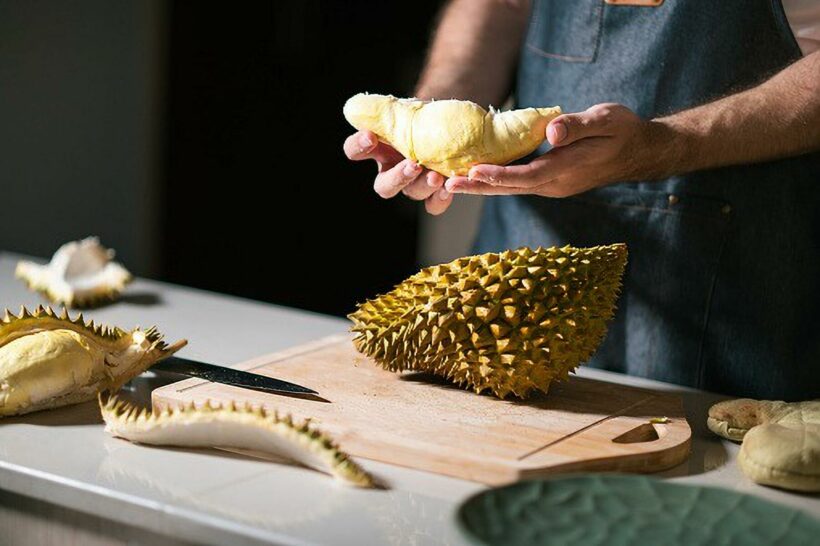How to open these 5 popular Thai fruits

With their bizarre textures, colours, shapes, sizes, and smells, Thai fruits are a delight for your eyes and taste buds. Sure, you can find these fruits anywhere in the world nowadays. However, they rarely taste as good as when you eat them in Thailand – especially when you come in the right season when they’re freshest!
As juicy and tasty as they are, exotic Thai fruits can be hard to open. Like many of us, you’ve probably struggled to open a durian, especially with its deadly spikey husk. You can, of course, buy the more expensive container of pre-cut fruit, but they are usually less fresh and tasty. So if you really want to enjoy Thai fruits, this article is for you. Below, we’ve put together the ultimate guide to safely cutting, peeling, and opening 5 of Thailand’s tastiest fruits.
Durian
Durian has a strong aroma often associated with stinky feet and even death. But to those who love this fruit, it’s considered a delicacy that’ll take them to another dimension. Although durian is almost always sold peeled and packaged at supermarkets and street stalls, it’s best eaten fresh when the husk just begins to crack. But with its sharp and spiky skin, how does one open a durian without getting injured? The truth is, opening a durian is not really that hard if you know the right way to do it.
First, lay a paper on the floor. Or if you can, it’s better to do it outdoors. Not only is it messy, but the fruit also releases a pungent smell that may linger in your house. The secret of opening a durian is in the faint brownish traces of a pointed star at the bottom of the fruit. These are the seams that separate the fruit’s different segments. So, start looking for the seams where the thorns grow in toward each other.
With a piece of cloth to hold the durian in one hand, poke straight into the middle of the “star” using a sharp knife with your other hand. Once the knife has penetrated deep enough, twist it left and right to open up the seams. You can then cut through the durian along these seams. Once the durian opens, dig your fingers in the segments to pull the durian apart. Repeat the same process along each segment until the custardy flesh is revealed. The next step is savouring the sweet and creamy flesh! Easy enough, right?
Every so often, you’ll get a whiff of something slightly foul while eating the flesh, but it shouldn’t be a nuisance if the durian is in the perfect ripeness.

Coconut
There’s nothing better than sticking a straw directly into a freshly cut coconut and scraping the soft white flesh with a spoon. But if you’ve ever tried to crack open a coconut, then you know how difficult it can be.
If you want to open a young Thai coconut the way people do it in Thailand, you’ll need a big cutting board and a good quality meat cleaver. Hold the coconut steady with one hand and cut the husk down to the hard shell with your meat cleaver. The best way to do it is by holding the cleaver at about 1 inch below the tip of the coconut at a 45-degree angle. You will have to strike hard enough to crack through the inner shell of the coconut, which is under the soft outer fibre. Make four or more cuts to form a square or hexagonal shape around the top of the coconut. Each cut should be done in the same manner as the first one.
Now that you have a square-shaped cut, use the sharp top tip of your cleaver to break the shell open. It should open easily if the cuts are deep enough. If not, you’ll have to do the cuts again using more force. You can stick a straw and drink the water right away. Alternatively, you can pour the coconut water into a tall glass and then use the cleaver to split the coconut open. This way, you can easily enjoy the sweet and creamy flesh.
Once you’ve mastered this technique, you no longer have to hit coconuts with a hammer or throw them on the ground in frustration! Enjoy fresh coconut water at home anytime you want.

Mangosteen
The mangosteen is another strange-looking fruit that grows abundantly in Thailand and many areas around Southeast Asia. Inside its deep purple firm shell is a flavourful bite-sized treat.
Opening mangosteen is not as hard as it seems. You can do it with your hands or with a knife. Using your hands to open mangosteen can be pretty messy and may leave purple stains all over your fingers. However, it’s very simple. All you have to do is hold it with all your fingertips in the middle of the fruit. Then, gently press the skin with your fingers to crush the purple shells. Once you crack the shells, you should be able to break open the rind to reveal the white mangosteen flesh.
If you want to use a knife, hold the mangosteen firmly on its side and make a cut using your knife. Cut shallowly around the circumference, just big enough for your fingers to get in. Be sure not to cut all the way through the middle, as you want to keep the flesh intact. Once you cut around the purple shell, pry it open with your fingers or pull each half apart with your hands. And you’re done! The flesh is separated into sections, much like an orange. Use your fingers to pull the sections apart and enjoy them one by one.

Custard Apple
Custard apple is a light green knobby-textured fruit about the size of a tennis ball. It might not seem delicious from the outside, but the custard-like flesh inside is sweet and creamy!
Compared to the three fruits above, opening a custard apple is very easy. Just cut the fruit in half by slicing it open lengthwise, from the woody stem to the bottom. Then, separate the two halves, and you’ll find creamy white flesh. If the custard apple is ripe enough, you won’t need a knife. Simply press your fingers into the middle of the fruit and pull it apart. The best way to eat the soft flesh is to scoop it out with a spoon. Yum!
Although the name is custard apple, it’s not actually apple at all. This means that you can’t eat the skin of custard apples like regular apples. You also shouldn’t eat the seeds. They’re small and hard, and biting down on one is undoubtedly not a fun experience.

Dragon Fruit
The dragon fruit may look unearthly with its hot pink skin and green scales that resemble a dragon (hence the name). But inside, you’ll find a lovely soft flesh that tastes like a sweet combination between a pear and a kiwi. The most widely available variation has pink skin with white flesh. The less common comes with pink skin and red flesh and yellow skin with white flesh. All of the varieties have tiny black seeds that are safe to eat. While they may look different, they actually taste very similar.
Although dragon fruits may look intimidating, it’s actually very easy to open. Lay the dragon fruit on its side on a cutting board. Then, use a sharp knife to cut the fruit in half by cutting straight down from the top down to the stem. You can simply use a spoon to scoop the flesh as you might do with a kiwi or avocado. It should be easy to lift the flesh out of the skin with a spoon, or alternatively, you can just peel the skin off using your fingers. Remember that the skin is not edible. Also, you should trim off any pink residues from the flesh because they can be bitter.
The dragon fruit is delicious to be eaten by itself, but you can also add it into a fruit salad, a smoothie, or even eat it with Greek yoghurt.

Opening these Thai fruits may take a lot of effort, but it’s part of the fun, right? Have other fool-proof and safer ways to open these tropical fruits? Feel free to share them in the comments!
If you’re trying to stay fit and healthy, check out our article on the best fruits and vegetables in Thailand!
Latest Thailand News
Follow The Thaiger on Google News:


























